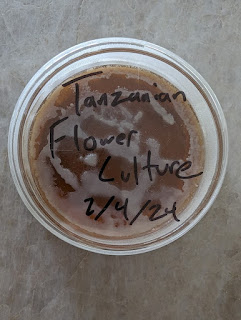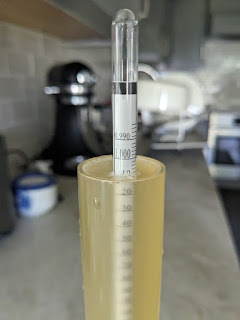Three Experimental Wheat Beers
First of all, we're live! I've been writing these blog posts (with input from Luke) mostly as a way for us to track our brewing internally for the last year, but I always figured we'd get around to putting these up. This is our first, rudimentary attempt at doing that, and this is the first post being written for the site.
Luke had a pretty busy weekend thanks to the Superbowl - as you might expect, pizza places tend to be busy places on Superbowl Sunday - so I did a little experimental brew myself. I've had pretty mixed results brewing by myself, so here's hoping this works out for me. I also wanted to prove to Luke that the mango-habanero beers I've been dreaming up can actually work, so here goes nothing.
I also knew that I wanted to try out a wild yeast that I caught on a recent trip to Tanzania. This yeast was isolated from a few bunches of flowers that I still haven't been able to fully identify. I want to be clear that under no circumstances would I eat foraged plants that I can't form a positive ID for. For this starter, I soaked the flowers in wort, waited until their was strong activity, strained out the flowers and inoculated a new starter with the dregs, waited two more weeks and inoculated yet another starter from those dregs. So far it has been a monster - it ferments the wort I've been feeding it with to near bone dry and is extremely flocculant. I wouldn't say that it introduces a lot of strong esters or phenols that I've been able to detect, but there does seem to be a bit of lactic sourness even though it has only been fed with hopped wort.So with this in mind, I thought I would try my hand at three distinct beers made from the same 50-50 Pilsen/Wheat wort (with a bit of oats and Caramunich II in there for color and flavor). Gallons one and two will be fruited with the mango-habanero discussed above and fermented with White Lab's fairly neutral Midtbust Kveik (WLP 4053), with the only difference being that gallon one was soured and gallon two was treated to a bit of Citra in the whirlpool. Gallon three also got Citra in the whirlpool and is fermenting with the fourth-generation dregs of the Tanzanian flower yeast.
Because this was such a small brew, I thought I would save myself a bit of time by using distilled water instead of our in-line filter. That probably wasn't the case, as I ended up making an extra trip to the store for more water when I realized I hadn't brought enough, and spent a fair amount of time figuring out Bru'n Water over our standard EZ Water Calculator. Bru'n Water is definitely a more detailed product, but damn if it didn't take a while to figure out.
As the kids say, sometimes it be like that.
I also decided to do a BIAB to keep things extra simple, partly because I thought it might save me a bit of time, and partly because we forgot to clean some of our equipment after our last brew. (It was below freezing outside and the hose was frozen, in our defense. We're paying for it now.) That more or less panned out, but I was reminded of how much I don't love squeezing out a hot, sticky, heavy bag.
The boil was pretty straightforward. I brought everything up to a boil for 10 minutes just to kill everything off and then I eyeballed about a gallon for the part I would be souring. I didn't want to evaporate it too much, since I knew I would be boiling it again the next day. I let that free cool under some tin foil while I boiled the rest of the wort. The nice thing about small batches is that they heat up and cool down pretty quickly. I like to whirlpool between 190F and 180F per Scott Janish's advice on the subject, but because it cools off so fast at that temperature, I tossed them in just below 200F and let it fall to around 170F over the next half hour or so.
Once everything was cooled down to about the right temperature, I packaged the wort into three fermenters with enough left to fill some mason jars with extra wort. We like to can them and use them for yeast starters.
The first gallon got a capsule of GoodBelly probiotic. A lot of homebrewers swear by the liquid GoodBelly, but all I had available were the capsules and I was curious about whether they would work. I got an airlock on it at around 105F, wrapped it in towels, and left it to do its thing for 24 hours. The next two got cooled down to around 80F and pitched with their respective yeasts.
After 24 hours, we pulled the sour wort out and tested the pH. That yielded a respectable 3.3 pH, which I would have assumed was too sour for me, but the taste test revealed a pretty tame tartness on the tongue. I have read that pH is actually not as good an indicator for sourness as buffering capacity, but I will readily confess that I haven't put in the work to understand what that means or how to test it.
This gallon got boiled for 30 minutes on the stove before I poured in a mason jar of refrigerated wort from the previous day. This cooled it down to 180F, at which point I let it free cool for half an hour to kill any microbes that might have colonized the jar. That wouldn't do in a lab setting, but it's probably enough to at least knock back any opportunistic microbes while the WLP 4053 I pitched after cooling it down took over.
All three are happily bubbling away at the moment and I'm eager to add in the mango and habanero to gallons one and two. For the mango, I'm following advice of Reddit user JuicyPancakeBooty here and adding Monin Mango Smoothie mix instead of fresh mangos, which (like a lot of fruit) have a habit of disappearing into a beer after their sugars ferment out.
For the habanero, I'm going to use one single pepper from my garden, which I froze several months ago for use in future projects, seeded and split between each batch. I'm playing it pretty safe here. It's totally possible that I'll be disappointed in the lack of spice in the finished beers, but that's preferable to two gallons of beer I can't drink without a glass of milk at the ready.
Stats:
Volume in Fermentor: 3x 1 Gallon
Starting Gravity: 1.045
Water:
- 2.4 Gallons Infusion Mash
- 2.6 Gallons Batch Sparge
Fermentables:
- 3 lbs Pilsen Malt
- 3 lbs White Wheat Malt
- 4 oz Caramunich Type II
- 4 oz Flaked Oats
- 3 oz Acidulated Malt*
- (For gallons 1 and 2, each) 23 oz Monin Mango Smoothie Mix + 1/2 habanero
Bittering/Flavoring Additions:
- 1.1 oz Citra whole cone hops (non-sour only)
Other:
- 1 lb Rice Hulls
- 1.5g Gypsum*
- 1g Calcium Chloride*
- 2.1g Epsom Salt*
- 0.8g Sea Salt*
- 1.3g Calcium Carbonate*
- 1/2 tsp Yeast Nutrient
Microbes:
Gallon 1:
- 1 capsule of GoodBelly Probiotics
- 1/2 Pack WLP 4053 Midtbust Kveik Ale Yeast
- 1/2 Pack WLP 4053 Midtbust Kveik Ale Yeast
- Yeast starter isolated from Tanzanian flowers
Schedule:
- Mash in with 160F water to hold at 151F for 60 minutes
- Drain and batch sparge for 20 minutes at 170F
- Boil for 10 minutes
- Transfer off approximately 1 gallon, cover and cool to 105F
- Continue to boil remaining wort for 50 minutes
- Cool to 200F, add whirlpool hops, cover and cool to 80F
- Transfer all wort to 1 gallon fermenters, oxidate and add lactobacillus or liquid yeast
- Wait 1 day for the gallon pitched with lactobacillus to sour and then boil for 30 minutes
- Cool to 80F and pitch liquid yeast
- Ferment for 7 days until primary fermentation finishes
- To gallons 1 and 2, add mango smoothie mix and habanero, frozen, thawed and crushed
- Continue to ferment for an additional 7 days
- Bottle and prime
Notes:
* These additions are calibrated to the distilled water I used for this batch, calculated using Bru'nWater 1.25 Calculator



Comments
Post a Comment